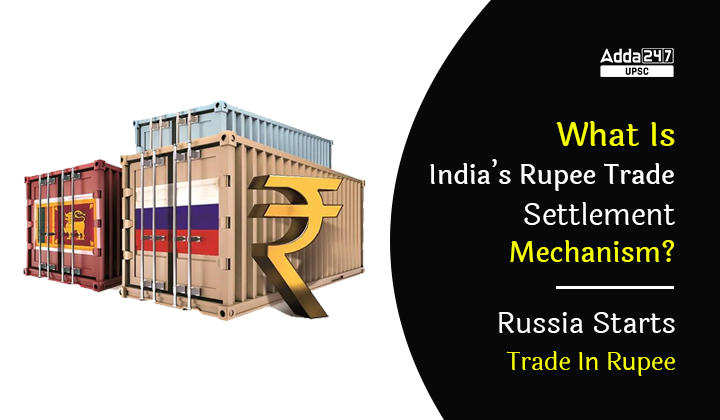Table of Contents
India’s Rupee Trade Settlement Mechanism: The RBI had in July 2022, notified India’s Rupee Trade Settlement Mechanism to reduce the depreciation of the domestic currency against the dollar. The idea was to not just reduce the pace of depreciation of the rupee against the dollar but also internationalise the domestic currency.
Subsequently, the commerce ministry notified guidelines that will enable exporters to get stipulated benefits under the foreign trade policy even if the export realisation is in the domestic currency, and not dollar.
Russia Starts Trade In Rupee: The “rupee trade” has taken off, with a few transactions involving Russian firms in December 2022. This was the first set of transactions since the RBI notified guidelines in July to promote the settlement of international trade in the rupee.
Why In News?
The finance ministry has recently asked all banks to nominate nodal officers, who would act as a single point of contact for exporters and importers who wish to settle external trade in the domestic currency as it seeks to promote the “rupee trade” in a big way.
What Is India’s Rupee Trade Settlement Mechanism?
- India’s rupee trade settlement mechanism is a method of using INR instead of dollars and other big currencies for international transactions.
- For importing and exporting goods and services, countries have to make payments in a foreign currency. Since the USD is the world’s reserve currency, most of the transactions are settled in dollars.
- For example, if a buyer in India enters into a transaction with a seller from Denmark, he/she first has to convert rupee into USD to make payment.
- The seller, after receiving those dollars, will have to get the amount converted into euro. Both the parties involved will incur the conversion expenses and bear the risk of foreign exchange rate fluctuations.
- India has been looking to bring countries that are short of dollars into the mechanism.
Rupee Depreciation in 2022: Indian Rupee at Record Low
| Did You Know?
For a currency to be termed ‘international’ it has to be widely accepted across the world as a medium of exchange for trade. As per the RBI, trade settlement in INR would reduce dependency on hard currencies including the US dollar, euro and yen. |
How Vostro Account Works?
- Over the last few months, a firm dollar has been weighing on imports for several countries around the world, thereby, creating an immediate need for an alternative.
- With the help of a vostro account, instead of paying and receiving US dollars, the countries can get the invoice of the goods and services made in Indian rupees if the counterparty has a Rupee Vostro account.
- When an Indian buyer wants to make transaction in rupees with a foreign trader, the amount will be credited to this Vostro account.
- When the Indian exporter needs to be paid for goods supplied, this Vostro account will be deducted, and the amount will be credited to the exporter’s account.
- For example, a bank of Denmark may approach an AD bank in India for the opening of Special Rupee Vostro account. After which, the AD bank will seek approval from RBI with details of the arrangement and post the approval granted by the India’s central bank, the Special Rupee Vostro account in the Indian AD bank by a Denmark bank will get operational.
- The trade settlement between the two parties can then start in INR. Also, the exchange rate between the currencies of the two trading nations may be market determined.
Special Rupee Vostro Account (SRVA) V/S Rupee Vostro Account
- Special Rupee Vostro Account (SRVA) is different from the already existing Rupee Vostro Account provided for under Foreign Exchange Management (Deposit) Regulations, 2016.
- As the settlement through Indian Rupees (INR) is an additional arrangement to the existing system that uses freely convertible currencies and will work as a complimentary system. This will reduce dependence on hard (freely convertible) currency.
RBI Launched Retail Central Bank Digital Currency (CBDC) on Pilot Basis
What Is The Relevant Provision In The Law?
- As per the broad framework for cross-border trade transactions in INR under Foreign Exchange Management Act, 1999 (FEMA), all exports and imports under this arrangement may be denominated and invoiced in INR; and the exchange rate between the currencies of the two trading partner countries may be market determined.
- Further, for settlement of trade transactions with any country, a bank authorised to deal in foreign exchange in India can open Special Rupee Vostro Accounts of correspondent bank/s of the partner trading country.
RBI’s Revised Bank Locker Rules To Be Effective From 1st Of January 2023
How India’s Rupee Trade Settlement will help India?
- Dealing and payments of most of imports, including crude oil, and several overseas transactions by India have to be paid in US dollar.
- India has to sell INR (Indian Rupee) to buy USD to pay OPEC (Organization of the Petroleum Exporting Countries) for its oil imports.
- Notably, INR is not fully convertible and therefore, it is often difficult to get buyers for it. On the other hand, USD has higher demand as compared to INR and its supply is controlled by the Fed.
- With trade being done in rupees, RBI will not be required to find buyers for INR to sell USD in return.
- It, therefore, increases the demand for the Indian rupee and brings in savings that has been accumulated from not having to remit conversion charges to banks.
- The Indian government-led by Prime Minister Narendra Modi is exploring to do this with other nations.
What is SAARC Currency Swap Framework? | RBI Signed Agreement With Maldives



 TSPSC Group 1 Question Paper 2024, Downl...
TSPSC Group 1 Question Paper 2024, Downl...
 TSPSC Group 1 Answer key 2024 Out, Downl...
TSPSC Group 1 Answer key 2024 Out, Downl...
 UPSC Prelims 2024 Question Paper, Downlo...
UPSC Prelims 2024 Question Paper, Downlo...





